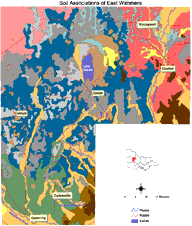Soils of the Eastern Wimmera
Beulah Association | Callawadda Association | Charlton Association | Donald Association | Glenorchy Association | Kalkee Association Unit 1 | Kalkee Association Unit 2
Kanya Association | Ledcourt Association | Morton Association | Murra Warra Association | Wal Wal Association | Major Soil Groups | Agricultural Significance of Major Soils Eastern Wimmera Soil Index
| The soils and landforms of this area were mapped in the early 1980’s by Nabil Badawy from the then Department of Agriculture. A report (‘Soils of the Eastern Wimmera’) was produced in 1984. This soil survey covered an area of some 750 000 hectares within the Donald, Charlton and Rupanyup 1:100 000 scale topographical maps. The western part of this mapped area is within the Wimmera Catchment Management Region whilst the eastern side falls within the North Central Catchment Management Region. The area consists of mainly gently undulating plains traversed by some perennial and intermittent streams. Other landforms include lake and lunette systems, dune and swale systems and some hilly terrain.  |
 Soil of the Eastern Wimmera | In this survey, the soils have been mapped into associations. A soil association is a group of adjoining soil types which occur in a pattern (i.e. are usually repeated in different parts of the surveyed area). Each soil association has been given the name of its principal soil type. Mapping was carried out at a 1:100 000 map scale which necessitated some generalisation. Users should exercise caution when interpreting map information as it presents a guide only as to the likely soil types in an area. In any one area soils can vary significantly according to landscape, geology and management. Any agricultural enterprise should be based on a proper on-site assessment of the soil and landscape. |
References
Badawy N. Soils of the Eastern Wimmera. Department of Agriculture, 1984.


